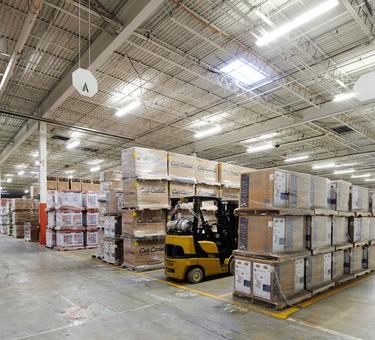The pandemic has accelerated changes in the retail environment, bringing significant implications for logistics real estate. In this installment, we revisit the intensity of use ratio between e-commerce and brick-and-mortar sales, examine supply chain patterns of highly impacted retailers, and provide a mid-quarter update on U.S. customer activity and utilization. Findings in these three areas add upside to logistics real estate momentum during the Recovery phase of the pandemic.
- The pandemic has accelerated the retail evolution. U.S. e-commerce penetration jumped to more than 25% in April 2020 from 15% at year-end 20191, pulling forward several years of adoption. Prologis Research estimates penetration of nearly 20% for 2020 as a whole vs. a pre-pandemic forecast of 16.9%.
- E-commerce requires more than 3x the logistics space of brick-and-mortar sales, according to 2019 data. The persistently high ratio supports the need for additional e-fulfilment space should e-commerce penetration keep gains made during the Stay-at-Home Economy phase.
- Brick-and-mortar disruption should have little impact on logistics demand and supply. Retailers that have recently announced bankruptcies2 represent a very small portion of logistics demand, and their distribution centers are located farther from population centers. These retailers together total only 20 bps of occupancy in the U.S. logistics real estate market.
- Most customers have adapted operations for Covid-19. Approximately 2/3 of respondents have operational safety measures in place, including staggered shifts, and roughly 5% of respondents reported suspended operations.
Conclusion
The window for customers to act on easing logistics real estate market conditions could be short. A recovering IBI points to the potential for a quick return to growth for logistics users, while e-commerce is likely to remain crucial to revenue generation even as societies re-open. Instead, much of the retail industry may be transitioning to include more space-intensive e-fulfilment operations.
Dirk Sosef, Prologis’ European Vice President Research and Strategy commented “While the latest research focuses on the U.S. markets, now that societies are reopening across Europe, similar demand trends can be observed as in the U.S. E-fulfilment supply chains need to keep pace with the continued double-digit online sales growth happening across Europe. This growth was a trend preCovid-19 and the Pandemic has only accelerated this across the region, pulling forward several years of adoption. As in the U.S., we have seen an increase of defaulted retailers but the diverse demand across the region continues to support resiliency.”
Further information can be found in the report, which you can download here.
